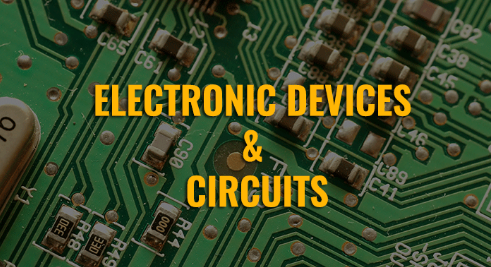EDC Interview Questions :-
1. What is Electronics?
The branch of engineering which deals with conduction of current through vacuum or gas or a semiconductor.
2. What is Semiconductor?
Semiconductor is a substance has its resistivity in between conductors and insulators. E.g. silicon, Germanium.
3. What is Conductor?
The substances, which allow electric current to pass through them, are called conductors. E.g. Copper.
4. What is Insulator?
Material, which does not allow the passage of electric current through them.E.g. Glass, wood, etc.
5. Explain Energy Band Diagram?
It is diagram drawn between interatomic spacing along the X-axis and the band energy along the Y-axis.

6. What Are Free Electrons?
The valence electrons, which are very loosely attached to the nucleus, are known as free electrons.
7. What is Doping?
The process of adding impurities to an intrinsic semiconductor is called doping.
8. What is Intrinsic Semiconductor?
Semiconductor in an extremely pure form is called intrinsic semiconductor. Its valence shell must be tetravalent in nature.
9. Explain Extrinsic Semiconductor?
Semiconductor in an impure form is called extrinsic semiconductor.
They are two types
- P-type
- N-type.
10. What is Valence Band?
The range of energy possessed by valence electron in an atom is called Valence band.
11. What is Conduction Band?
The range of energy possessed by conduction electron in an atom is called conduction band.
12. Explain Forbidden Energy Gap?
The separation between the conduction band and the valence band on the energy band diagram.
13. What is P-n Junction?
When P-type and N-type are suitably joined together by the conducting surfaces of these two semiconductors is called P-N junction.
14. What is Forward Biasing?
When a diode is forward biased the current is produced because the holes in the P-region and electron from N-region moves towards the junction. The depletion region formed will be very small hence recombination occurs and current will be produced.
15. What is Reverse Biasing?
When a reverse biased voltage is given an electron from N-region and holes from P-region moves away from the junction,hence the depletion region formed is very high and hence a small current will be produced due to minority carriers.
16. Explain Reverse Resistance?
The resistance offered by the diode in its reverse biased condition is called reverse resistance.
17. Explain Forward Resistance?
The resistance offered by the diode in its forward biased condition when a voltage is given is called forward resistance.
18. What is Transition Capacitance?
The P-N region on either of the dielectric media act as the plates hence we have components for making a plate capacitor the junction capacitance is called transition capacitance.
19. What is Power Rating?
The power rating of a diode is Explain d as the maximum value of power that can be dissipated without failure if V f is the forward biased voltage and I f is the forward biased current.
Pd= V f x I f.
20. Explain Diffusion Capacitance?
This capacitance effect is present when the junction is forward biased it is called diffusion capacitance.
21. Explain Drift Velocity And Drift Current?
When an electric field is applied the charge carriers moves in the opposite direction and produce current this result is drift current and net average velocity is called drift velocity.
22. What is Transition Time?
Only after the minority carriers are swept of the junction the diode voltage begins to reverse and the diode current decreases exponentially the time which elapses between and when the diode normally recovered is the called transition time.
23. What is Storage Time?
When the conduction diode is reverse biased the voltage does not become zero. Immediately up to time t 1 the diode is conducting in the forward direction. The time interval t = t 2 –t1 during which the stored minority carriers reduces to zero is called storage time (t s).
24. Why are the coupling capacitors required?
To filter the Dc term from the Input signal , Collector output in amplifiers.
25. What is meant by thermal stabilization?
Maintain a constant operating point when temperature varies
26. Explain why reversal of phase occurs in a BJT CE Amplifier.
As Base voltage increases, base current increases, then collector current increases so voltage drop across Rc increases so out put voltage decreses.
27. What happens if an amplifier is biased at cutoff or at saturation?
In cutoff region Ic is 0, in saturation region Vce is almost Zero.
28. What is the significance of the bandwidth of an amplifier?
Bandwidth specifies the input signal frequency range that can be applied to amplifier to get maximum gain.
29. What is meant by Gain-Bandwidth Product? What is its significance?
The name itself expressing it is the product of gain of a device and its bandwidth. For any system (circuit) gain bandwidth product is constant, if gain increases bandwidth decreases vice versa.
30. What are the advantages of using a FET instead of a BJT?
FET has high input impedance, lower noise, low to medium gain,
31. What are the specifications of the SCR ?
gate trigger voltage, gate trigger current, holding current, on-state voltage, peak gate power dissipation.
32. Can we interchange the source and drain terminals in a FET circuit? Can we do the same with the emitter and collector terminals of a BJT circuit?
We can interchange drain and source but we cannot change emitter and collector because emitter and collectors dimensions and doping concentration is different
33. What is a MOSFET? How is it different from a JFET? What are its typical applications?
Metal oxide semiconductor can be operated in both depletion and enhancement modes, but Junction field effect Transistor can be operated in depletion mode only.
![MCQs [2024]](https://engineeringinterviewquestions.com/wp-content/uploads/2021/02/Interview-Questions-2.png)